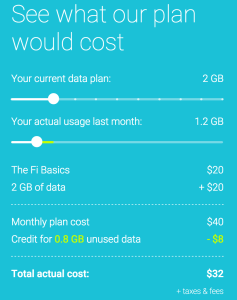Cellular service has turned us very dependent on carrying the web in our pockets (and even on our wrists). That dependency can translate to convenience until the data is inaccessible or cost prohibitive. That is often the case for international travelers who face high roaming costs if using their US carriers (unless you are a T-Mobile customer and on a plan of $50 or more per month – free international data).
It was only a matter of time before Google brought their weight into the cell service arena and they did it without having to build a single wireless tower. For US service, the new Google phone service, called Project Fi, will use Sprint and T-Mobile for phone service. In fact, it will automatically switch between carrier towers depending on the strength of the provider.
The New Google Phone Service
Signing up
To sign-up, you will need to request an invite. These invites are only issued to gmail users, not users that have their own domain with a Google Apps account. To sign-up, go here. To read all about the service, check out Google’s FAQ page here.
Refund For Unused Data
While all of the that is great and interesting, the really interesting part comes into play with how Google is going to bill its customers. Instead of charging customers a set amount for data whether they use it or not, or even allowing the user to roll it over, they will refund you for any unused data in a month! That’s right – if you pay for 3GB and only use 1GB, they will refund you the cost of the extra data you did not use.
Free International Data With Plan (and texting too!)
Not only is that payment structure new and interesting, but the way Google plans to handle roaming is great too. For Google Fi customers, your data roaming will be all-inclusive in 120 countries around the world. That means that if you pay for 3GB of usage in the US, that same data plan will work anywhere in those 120 countries at no extra charge. While voice will not be free while roaming ($.20 per minute), the text messaging will be free.
Note: international roaming will be limited to 3G.
The Cost Of The Plan

Now, let’s get to the cost of the plan. The plan itself is $20 for the talk and text. That is it – no contract! From there, you can add 1GB of data for $10 each. So, if you think you are going to use 5GB of data, your total bill would be $70. But, let’s say you only end up using 2GB, you will receive a refund of $30 for that unused data, and it is not just rounded to the nearest GB for the refund!
The Hitch – Equipment
While some tech writers and bloggers are frustrated and calling out Google for only having support for their own Nexus 6 phone at the start, I think that is actually a smart move. To begin, you need to receive an invite (which you can request here). From there, to take advantage of this new plan, you will need to purchase a Nexus 6 if you do not already have one. Google says it is the only phone with the built-in capabilities at this time to handle the network hopping that makes Google Fi work.
The smart part of the plan is that this automatically is going to limit the rollout since it is only for Nexus 6 users. This way, Google gets to control the adaptation of their plan and check its effectiveness without actually limiting it to a certain group/number of people. While the invites will be controlled, limiting the first users to Nexus 6 users allows Google to maintain a technical knowledge of how well the system is working without it being dependent on various phones’ ability with cell service or data handling.
Eventually, it will be rolled out to other users as well, but for now, you will need a Google Nexus 6. If you do not have one, you can purchase one at the point of enrollment into the program for $650 (for 32GB), $700 (for 64GB), or a new payment plan of $27.04 per month for the 32GB and $29.12 for the 64GB phone (for a total of 24 months).
Summary
I am really excited about this new plan. While it is not going to be the best price for data-hungry users in the US or family plan customers, it will be a great option for those who travel internationally or only use a smaller amount of data. Of course, the cheapest way to communicate in a foreign country is to purchase a local SIM (I pay $6 per month and get a total of 300 minutes, 200 SMS, and 1.7GB of data in Greece), but this could very easily be the next cheapest avenue. Even though you pay for phone calls, you could use a service like Google Voice to make calls and get around that – which is probably what Google is hoping you do.









